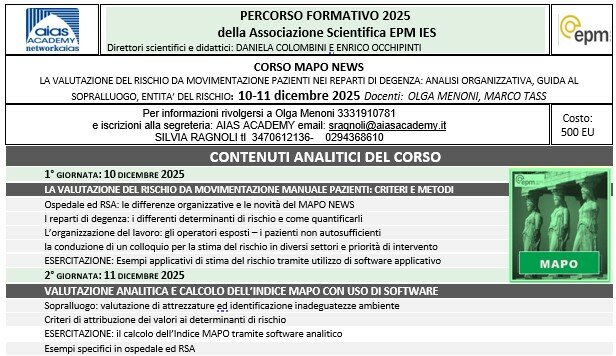Un documentario di EPMIES , per tutti , anche per bambini e ragazzi..sempre...costruttivo...da guardare e da far vedere anche nelle scuole:
IO MANGIO, TU MANGI.......LORO SI AMMALANO, Prodotto da Daniela Colombini "ESPO 2015 Milano". Il film è in Italiano, con scritte in Inglese, ma la maggior parte del film è in immagini.
A documentary by EPMIES, for everyone, also for children and young people ... always ... constructive ... to look at and to show also in schools:
I EAT, YOU EAT ....... THEY HURT. produced by Daniela Colombini "ESPO 2015 Milano". The film is in Italian, written in English, but most of the film is in images.
HERE THE MOVIE "I eat, you eat? they hurt
IL FILM EXPO 21 6 15
C.F. / P.Iva: 97644490159
Tel: 025468181
epmies.corsi@gmail.com
Via Cadore 2
20135 - Milano - Italia
Epm International Ergonomics School
Epm International Ergonomics School C 2022 - Powered by Logos Engineering

Privacy & Cookie Policy



Multitask analysis for OCRA, NIOSH, TACOS and PUSHING PULLING)

Ergonomics Industrial Journal ISSN:2577-2953 DATA 7-3-23
DOI:10.23880/eoij-16000302
Pushing and pulling tasks: practical techniques and criteria for measuring and interpreting detected forces using digital versus traditional analog dynamometers. Suggestions for implementing Standards.
Daniela Colombini1, Marco Cerbai1,2, Robert Fox5, Alberto Pigini1, Enrique Alvarez 1,4, Natale Battevi1,3, Enrico Occhipinti1,3,
1 EPM IES - Ergonomics of Posture and Movement International Ergonomics School (Milan, Italy)
2 Safety Work S.r.l. (Imola, Italy)
3 University of Milan
4 Cenea (Barcelona-Spain)
5 Chair, US TAG to ISO TC159/SC3 for Anthropometry and Biomechanics
CORSO ERGOCHECK COSTRUZIONI CIVILI

.jpeg)
PATRICIA ROSSANA BRANCO BRASIL patriciarossafa@raciocinioergonomia.com.br
NEW PAPER
Review article
The Multitask General Exposure Index (MultiGEI): An original model for analysing biomechanical risk factors in multitask jobs featuring weekly, monthly and annual macro-cycles
Author links open overlay panel DanielaColombiniaEnricoOcchipintiaRobert R.FoxbEnriqueAlvarez-CasadocAriel OrleiMichaloskid
Highlights •
Analysis of daily rotations when performing repetitive and manual lifting tasks.
Rotations over periods longer than a day: definition of macro cycle (e.g. weekly, monthly, yearly).
The reconstruction of the “artificial working day, representative of the macro-cycle.
The “Multitask General Exposure Index” (MultiGEI, the new approach (derived from for rotations daily rotations) over periods longer than a day.
Examples of application of the Multitask General Exposure Index (MultiGEI) formula to calculate the final exposure indexes.
Abstract •
The assessment of exposure to biomechanical risk factors requires multiple different working risk factors to be considered and integrated in some way to determine overall exposure levels and risk. A particular challenge is posed when workers rotate between different tasks not only on a daily basis but over longer macro-cycles (which may be weekly, monthly, or even annual). There may be large numbers of rotated manual tasks, each with a different level of exposure and distribution pattern. This makes the multitask analysis more complex insofar as it must factor in multiple work activities over extended periods of time. This article presents a new general model specifically adapted to evaluating multiple tasks rotating over longer macro-cycles: the MultiGEI (Multitask General Exposure Index). The MultiGEI model uses similar criteria to current models to study daily rotations in tasks involving repetitive movements and exertions of the upper limbs (OCRA method) and manual lifting (the Revised NIOSH Lifting Equation or RNLE and Sequential Lifting Index). It can be applied to a variety of production and service sectors (agriculture, building construction, cleaning, retail, packaging, canteens, healthcare, etc.). It can also be applied to data obtained by other methods (other than OCRA and RNLE, here not presented) that specifically consider the relevant aspects of which tasks, their duration and their intrinsic risk score. The proposed approach is presented along with examples of applications, and advantages and limitations are discussed. A video showing examples of calculations carried out using free software, is also available.
Article link: https://authors.elsevier.com/sd/article/S0169-8141(21)00130-X
ENGLISH BOOK
COLOMBINI D, OCCHIPINTI E
Risk analysis and management of repetitive actions: a guide for applying the OCRA system ( Occupational repetitive actions).
CRC press Taylor& Francis,2016
Features OCRA methods and tools:
- Presentation of different tools in relation to different needs tools ( downloaded for free );Analysis of rotations between multiple repetitive tasks;
- Several examples of applications;
- Role of occupational physician in risk management: health surveillance techniques and affected workers re-allocation
Summary
This book covers the application of the OCRA ( Occupational Repetitive Actions ) method. The methods make up a system dedicated to the analysis and management of the risk of biomechanical overload of the upper limbs. The book focuses on the OCRA checklist which presents various models from the most simplified, to the most complex. It describes methods, criteria, procedures and tools on how to perform such an assessment, in line with international standards. The book provides you with the correct methods and tools for prevention of upper limb work related musculoskeletal disorders no matter what the working environment is or what the international standards dictates.
.jpeg)
.jpeg)
ITALIAN BOOK
D.COLOMBINI, E.OCCHIPINTI
L'analisi e la gestione dei rischio da movimenti ripetitivi
manuale per l’uso del metodo OCRA per la gestione del rischio da sovraccarico biomeccanico in lavori semplici e complessi,
FRANCO ANGELI editore
MOVIE WITH APPLICATIVE EXAMPLES
Presentation of application examples of work analysis characterized by multi-task turnover with a higher cycle than the day: annual, monthly (or weekly) macro-cycles, through the use of software (in Excel), specifically prepared:
ERGOepmVINCIocraNIOSHpushTAengYEAR
ERGOepmVINCIocraNIOSHpushTAengMONTHweek
Free software in Excel by Scientific Association EPMIES
(see ffree software)
https://youtu.be/F4wn67x9ppo
NUOVE NORME ISO TR (Technical Report)
